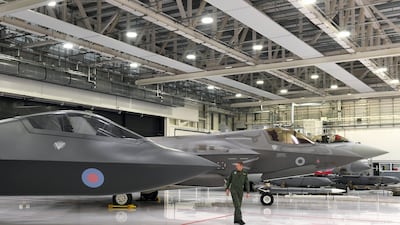The fighter jet will be very different to all that has gone before. Able to hoover up a city’s data in a second, equipped with directed-energy weapons, ultra-smart bombs that loiter over a target, fast, invisible and capable of performing unbelievable manoeuvres.
But the reality of a new European fighter, independent of American technology, will be severely tested over the coming years with politics threatening to scupper the vision.
This week France, Germany and Spain signed a contract to spend €100 billion ($121bn) on what will be Europe’s biggest ever defence project, developing a sixth generation fighter.
But nearby, another similar project is more advanced, with Britain, Italy and Sweden developing the Tempest future combat aircraft.
If the two projects combine, defence experts say, there is a chance they could create a world-beating aircraft.
The problem is that European defence projects have a habit of unravelling as competing countries’ requirements and rivalries come to the fore.
The French want an aircraft capable of flying from an aircraft carrier and carrying nuclear weapons. The Germans are more interested in non-combat capabilities. The British are eager to get on with it and perhaps prove that in the post-Brexit world they are capable of producing something special.
“There’s no reason why the two European projects couldn't unite and produce an outstanding next generation aircraft, they are more than capable,” said Doug Beattie of the IISS think tank. “But the difficulty isn't really the technology, it’s the politics.”
Another senior defence industry source believes that with Europe “savaged by the pandemic” there is a question mark over affordability. “Perhaps once the bad taste of Brexit has gone away there could be a political and industrial alignment.”
For the Germans, the fighter is more about demonstrating political unity, said Justin Bronk of the London-based Royal United Services Institute (Rusi) think tank. “Germany sees this as an absolutely essential, high level, political project and the failure of it would be seen as a huge backward step.”
However, the politics could get even more difficult if the Greens form part of the next German government and veto the military project.
If the threat of cancellation, political battles and money doesn’t see both projects derailed then the potential of what could be delivered should prove persuasive.
While the Franco-German undertaking is embryonic, more than 2,000 engineers, developers and scientist have been working on the British-led Tempest future combat air system, aiming to achieve operational flight by 2035.
It is understood that the project has promise. “There's a lot of classified activity that we don't have access to,” said Mr Barrie.
Industry sources are upbeat. “It will be a massive flying supercomputer that can suck up in a second as much data as London produces,” said one executive. “It will be highly manoeuvrable, near invisible and very fast.”
The British are also developing the "loyal wingman" concept, which has an accompanying fighter-drone, overseen by the pilot, that can target and shoot down enemy aircraft as well snoop for intelligence and carry out surveillance.
On top of a laser weapon, its bomb-bay will carry ultra-smart missiles that can be fired ahead, loitering to see if an enemy appears and then reacting very decisively.
The aircraft, which can be flown unmanned, will use ‘multi-domain-integration’ of the sea, land, air, space and cyber domains. It will incorporate artificial intelligence using deep learning to penetrate and discover enemy vulnerabilities and understand the broader picture. Similarly, the Co-operative Engagement Capability will allow Tempest, which can also carry swarms of small attack drones, the ability to co-operate on the battlefield, sharing data to co-ordinate attack or defence.
It will have a fully integrated sensor giving 360° situational awareness, similar to those found in modern cars yet instead of tens of metres this would stretch out to beyond 100 kilometres.
If the developments in the British-led Tempest project are matched with the advanced capabilities of the French, Germans and Spanish, experts believe the resulting aircraft could prove breath-taking.
“There's a whole host of ways that the two programmes could co-operate to reduce the overall burden, while still providing workshare to create a highly capable aircraft,” said Mr Bronk, Rusi’s research fellow for airpower and technology. “For example, the French would be very keen to have British input on the engines as Rolls Royce is the outstanding turbine manufacturer. And the Germans are more comfortable working with BAE Systems because of the experience with Tornado.”
In fact, the Europeans do have a history of working successfully together on projects. The Tornado fighter-bomber, still in service in Saudi Arabia, was an Anglo-German-Italian aircraft operational for four decades and combat-proven in Iraq and Afghanistan. Likewise, the Typhoon fighter currently operating over Syria was another hybrid of four countries.
Indeed, there have been successful Anglo-French collaborations such as the Gazelle and Puma helicopters, although more latterly there have been more solo Gallic pursuits, which while successful, like the Rafale fighter, have come at financial cost.
There is also suspicion over French machinations from previous failed defence collaborations. “There's only two reasons why the French participate in a multinational defence programme: to either seize it or to kill it,” said an RAF commander.
While Justin Bronk accepts there’s a “high level of confidence” in the Tempest, it is still “at quite an early stage".
Meanwhile, the other European project, flush with a €3.5bn ($4.25bn) injection, has a clearer idea of the aircraft required so it is not “necessarily behind, it's just, it's a different process”.
Like others, Mr Bronk suggested that the Germans or Spanish could potentially break away and unite with the British, although the politics of this are currently difficult with the lingering sourness over Brexit and Covid-19 vaccinations.
There is also always a danger that a unified project could produce “a horse built by committee,” said Mr Barrie.
But there is a chance the fighter could help heal the wounds caused by Brexit and produce a spectacular European defence project envied worldwide, perhaps even by the Americans.



